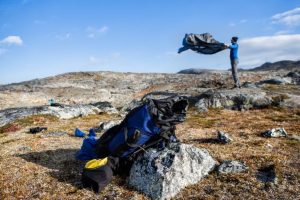Written by Guest Contributor on The Prepper Journal.
Editors Note: A post from Melanie Campbell, the enthusiast behind Ardent Footsteps, to the The Prepper Journal. Following the links she has provided is recommended to get the detail behind the thoughts and to get some sound tips on making sure your gear is bad-weather ready. For a pleasure trip or for survival. As always, if you have information for Preppers that you would like to share and possibly receive a $25 cash award, as well as being entered into the Prepper Writing Contest AND have a chance to win one of three Amazon Gift Cards with the top prize being a $300 card to purchase your own prepping supplies, then enter today!
Even though my fascination with the natural world didn’t start until I was in my late 20’s and stressed out from work and responsibilities, I still remember vividly all of the camping adventures I had with my parents. I have about 20 years of experience in camping, and I’ve gone through all of the weather conditions and all sorts of other tricky situations.
And one of the most common and annoying problems that can dampen your camping trip in no time is if you didn’t come prepared to deal with rain. That’s why I decided to give you a few tips on how to get ready for camping on rainy days or survive them as safely and comfortably as possible.
Make a Wise Choice on Campsite Location
When I was a child, my family had a beautiful tradition. Every year, for my birthday we would go out in the woods and turn the celebration into three-day camping. As I was born during summer, the weather was ideal for this kind of activity. However, on my eighth birthday, the sky just broke. As rain poured, our tent, pitched at the base of a north facing peak, became soaking wet. My sleeping bag, unlike everything else in the tent, did not float. That’s when I learned the first and by far the most valuable lesson – choose your campsite location wisely.
In general, you should look for high, flat ground upon which to pitch your tent. Additionally it is important that the area is well-drained, so you don’t end up swimming in your sleeping bag. Also, if you can, choose a campsite that is hidden by big trees, which will provide you with natural shelter from both winds and overexposure to the sun.
On the other hand, avoid campsites that are located too near bodies of water or under overhanging branches which will catch water at first and then channel it right to you. Sloping and depressed areas are a bad choice because water tends to flow through and accumulate here. And remember to avoid camping under that one lone tree, because this significantly increases your chances of getting struck by lightning.
Waterproof Your Tent
Your tent will usually be able to prevent water from pouring in when the rain is light. However, as tens are regularly cleaned, exposed to heat, wind, and all sorts of weather conditions, they wear down bit by bit, which affects their waterproof features. Even the packing and unpacking of tents will produce wear over time.
If you want to stay dry and comfortable waterproofing is an absolute necessity. You’ll need to take care of tent’s walls, floor, seals, and seams and maybe even install a rain fly. If you want to learn more about waterproofing techniques, read this guide.
Plastic Bags are a Must-Have
When it comes to rainy days, plastic bags are life savers. They are waterproof, and they will keep the majority of your stuff safe and dry. Make sure to bring plastic bags of all sizes and shapes.
You should use them to segregate clothes and everything else in your backpack, line your bags to protect your belongings and most importantly keep your food dry and protected.
Cheaper plastic bags are usually not reusable, but even those can serve the purpose for a single outing if you don’t have any other choice. However, don’t forget to dispose of them properly after use.
Take the Tarp Inside
If you are a passionate camper, you probably already have a tarp. (You need one in your survival gear even if you don’t plan on camping.) They should be placed directly on the ground, beneath your tent. They create an extra layer of protection and barrier against water and when there is no rain, morning dew. You can get a classic woven polyurethane style tarps for not more than fifty dollars.
If you place a tarp inside your tent rather than outside, as you probably do in most of the cases; you’ll find it offers a much better protection from the water this way. As most modern tents come with a built-in floor, this gives you bot extra moisture and heat-loss protection.
Insulate the Ground
Except for placing the tarp, you should take care of other types of insulation. Add a bivvy bag will protect your sleeping bag from moisture, and retain a little heat. Doubling up on the sleeping pads is also a good idea. A lot of body heat can be lost to sleeping on the ground, even in a warm desert, where there are real creepy-crawlies seeking warm thing to cuddle up with…
Once you get in your bag and decide to go to sleep, make sure to keep your face exposed. Breathing into the bag may cause down insulation to get wet, which will affect its performance.
Mind the Signs of Hypothermia
Staying wet from the rain for a long time can put you at an increased risk of hypothermia, which often happens when rain or snow surprises you on while off the grid.
The most obvious signs are following: shivering, slurred speech or mumbling, slow and shallow breathing, weak pulse, drowsiness and low energy, clumsiness or lack of coordination, confusion, and loss of consciousness.
If this happens to you, or someone you know, rush them to the hospital. However, before you get there, you should start helping the person by removing all the wet clothing and covering them with dry blankets, clothes, and sleeping bags. Keep them as warm and as calm as you can and monitor their temperature.
Dry Out Your Wet Camping Equipment
All of your wet equipment, from clothing to shoes to sleeping bags to tarps to tents, and everything else, needs to be vented. As soon as you have a chance, unpack your bags and let your stuff thoroughly dry. Otherwise, molds, mildew, and other unpleasant scents will develop, ruin the fabric, and corrode metal items.
Editors Note: The editor recommends you do this will all you camping and survival gear on a regularly scheduled basis. No matter where you live. In the humid south for moisture, in the dry west for cracks from loss of moisture and loss of flexibility within the materials; check for mold as a result of incomplete drying prior to storage, cracks, torn or failing seams, items that looked good a few months ago but now need to be replaced. Vigilance pays off.
Bio: Melanie Campbell is an outdoor and camping enthusiast behind Ardent Footsteps, enjoying this wonderful world since 2010. She shares expert advice when it comes to camping and outdoor trekking. With the main focus on making the most out of camping and outdoor adventures, Melanie will make you want to go out today!
The post Stay Dry, Safe in Camp in the Rain appeared first on The Prepper Journal.
from The Prepper Journal
Don't forget to visit the store and pick up some gear at The COR Outfitters. How prepared are you for emergencies?
#SurvivalFirestarter #SurvivalBugOutBackpack #PrepperSurvivalPack #SHTFGear #SHTFBag




No comments:
Post a Comment